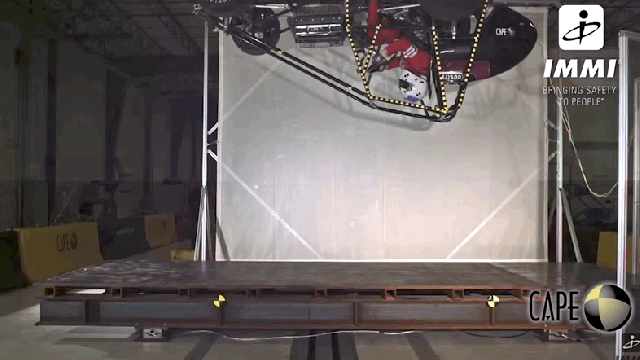We often talk about crash tests for street cars, since those are the cars we drive and knowing how they’ll handle an impact is important. But race cars need to be crash tested as well, because safety in auto racing is more than just slapping on a halo or something similar and immediately calling it good.
I was poking around about Formula One this week when I noticed a mention of F1 crash testing, and it occurred to me that even as a motorsports fanatic, crash testing for race cars isn’t something I’ve ever thought much about. We discuss safety improvements like the halo while we watch cars crash on track and hope for the best for the drivers inside, but it can be easy to overlook the thought that race cars need to go through a similar crash-test regimen as street cars—except a whole lot more intense.
F1 introduced crash testing in 1985, and its website says current testing consists of moving impact tests, static load tests, and rollover tests. Its website describes the moving tests as such:
The dynamic impact tests are performed on the front, sides, and rear of the chassis, plus the steering column. The driver’s survival cell must remain undamaged throughout. The weight of the test chassis, including a crash dummy, is 780 kg. The front impact test is done at a speed of 15 metres per second (54 km/h), the lateral at 10 m/s (36 km/h) and the rear at 11 m/s (39.6 km/h).
The speeds may seem low, but are chosen to allow the most accurate measurement of the car’s ability to safely absorb the unwanted momentum of an accident. The limits for maximum deceleration, energy absorption and deformation are precisely defined. For example, during the frontal test the deceleration measured on the chest of the dummy may not exceed 60G (approximately 60 times body weight) within three milliseconds of the impact.
But the coolest thing about crash testing race cars, aside from the fact that it keeps drivers safer, is watching just how wild the tests are.
Here’s a sprint car being dropped upside down from the ceiling, as these things are known to go tumbling when they crash:
And here’s one going straight into a wall:
F1 usually does its testing at the Cranfield Impact Centre in England, the series’ website said, and a couple of videos from 2006 pop up when those keywords are put into the YouTube search bar:
It’s strange to think of race cars crashing on more than just the track, but, just like street cars, it’s a good thing they go through the motions with a dummy in the seat before a real person takes over.
